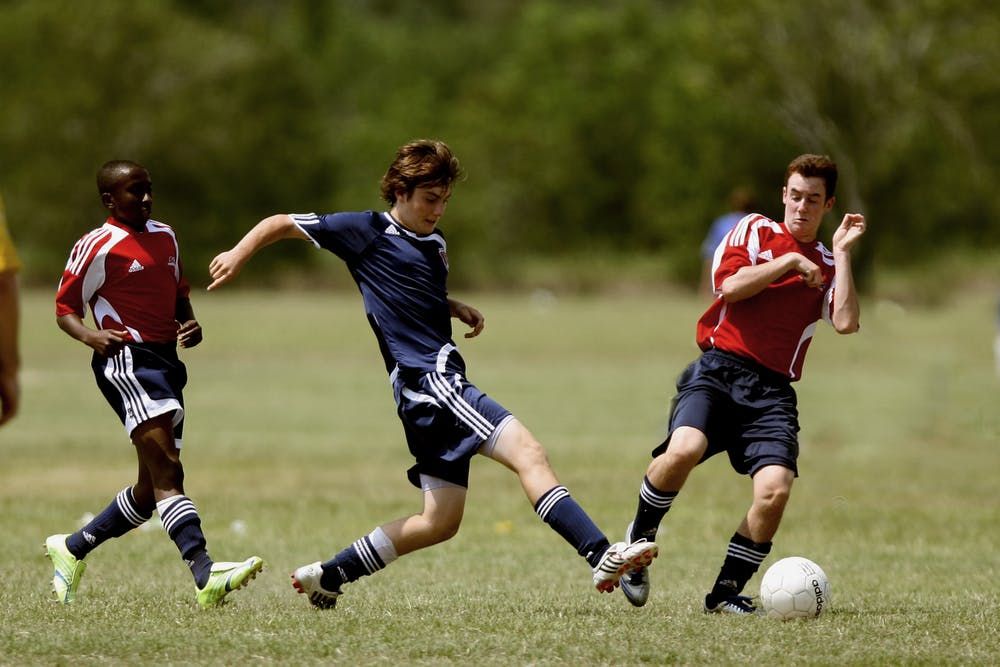Common Soccer Injuries Treated at MidAmerica

Did you know World Cup soccer players run on average seven miles per game – more than any other sport? Soccer is a wonderful cardiovascular exercise, but it can leave the players susceptible to many types of musculoskeletal injuries.
One NCAA study of prevalent men’s soccer injuries found:
- The most common injuries were muscle strains (25.8 percent), ligament sprains (25.3 percent), contusions (20.3 percent), and concussions (5.5 percent).
- Of those injuries, players suffered ligament sprains of the lateral ankle (12.2 percent), hamstring muscle strains (7.5 percent), concussions (5.5 percent), and adductor (groin) muscle strains (5.5 percent).
Our team of sports injury specialists at MidAmerica Orthopaedics can treat nearly any soccer ailment or injury – often more efficiently than at a traditional hospital. Patients get comprehensive care and direct access to a range of diagnostics that get them back in the game as quickly as possible. Here are some common soccer injuries to come through our doors:
Sprained Ankle
A specialist will base your treatment for a sprained ankle on the severity and type of sprain you experienced. High ankle sprains, for instance, are most often caused by a sharp, outward twisting of the foot and ankle. This can stretch the ligament, causing tears, in severe cases resulting in a rupture of the ligament.
While high ankle sprains stem from an outward twisting of the ankle, the more common, low ankle sprains are caused by an inward twisting. For either type, you might need X-rays to rule out a bone fracture. Symptoms of a sprained ankle include:
- Pain when rotating the ankle
- Inability to walk
- Swelling
- Redness or bruising
Treatment options for high ankle sprains may include the use of a cast, splint, or brace, as well as physical therapy (PT) to strengthen the ligaments and ankle. For severe cases such as a displaced tibia or fibula, surgery may be necessary. If you’re experiencing ongoing swelling or pain from a soccer-related foot or ankle injury, it’s time to see an orthopaedic foot and ankle specialist and get started on the best treatment plan.
Foot fracture
Depending on your level of pain and other indicators, your physician might order an MRI to determine whether you’ve suffered a fracture, a serious injury of the ligaments, or damage to the surface of your ankle joint. Here are two common foot fractures in athletes:
Avulsion fracture: This type of fracture can accompany an ankle sprain. It occurs when a small piece of bone is pulled off the main bone by a ligament or tendon, which can happen when an ankle is rolled.
Jones fracture: This type of fracture occurs within a small section of the fifth metatarsal – the middle bones in your feet – that receives less blood than other parts of the foot, leaving it susceptible to injury. Fractures can either be stress fractures, which occur over time or can result from an acute injury.
A fracture is typically treated with the PRICE method (protect, rest, ice, compress, elevate), but you may also need a cast, boot, or crutches, depending on the severity of the fracture.
Knee Injuries
Here are three common knee injuries we treat in soccer players:
ACL injuries: Tears and sprains of the anterior cruciate ligament (ACL) are the most common knee injury among soccer players. Because knee ligaments are stiffer than muscles and tendons, they are particularly vulnerable to damage. Injuries are caused by direct trauma or overextension of the ACL, the severity of which will determine your treatment plan.
Meniscus Injury: The meniscus is a piece of cartilage that pads the space between the femur and tibia. Meniscus tears are painful and result from twisting, pivoting, decelerating, or a sudden impact.
Runner’s Knee: Soccer players often experience runner’s knee, a term for general pain from overuse of the knee joint. Over time, the impact and resulting inflammation irritate the tissues in and around your kneecap.
An orthopaedic specialist will often recommend PT to rebuild your strength and flexibility for any of these knee problems. Treatments for more serious injuries may include steroid injections or surgery.
Head Injuries
Heading the ball is just part of the game – but that doesn’t always make it safe. Nearly 27,000 head injuries from soccer were treated in emergency rooms in 2018. Soccer players have suffered concussions from contact with other players, the ground, goalposts, and even the ball.
A blow to the head can cause symptoms ranging from blurred vision and headaches to nausea and difficulty sleeping. Fortunately, most concussions aren’t serious. But a head injury sustained on the soccer field should be examined promptly at a concussion clinic for the proper diagnostics and best treatment plan.
Achilles tendonitis
The Achilles tendon connects the bone of the heel to the calf muscles. A condition can develop when the tendon becomes inflamed, leading to pain and stiffness. Frequent jumping and running during scrimmages and games can bring it on gradually, and you’ll need treatment if you want to keep playing. In more severe cases, the tendon can rupture, which typically will require surgery.
To stay at the top of your game, be sure you have the right team of specialists on your side. A physical therapist and orthopaedic specialist at MidAmerica will take a holistic approach to your treatment so you can rebuild your strength and avoid further injury in future games.
At MidAmerica Orthopaedics you’ll get access to experts who treat a wide range of soccer-related injuries and conditions. To contact our Sports Medicine Clinic in Palos Hills and Mokena locations or learn more about our programs for treating sports injuries, call us at (708) 237-7200.

